#also looking back Aman should not have been doing all that at the disco. that man should not be at the club he needs to be getting
Text
folks i'm going to need to you sit down for a sec. sit down. are you seated? ok good
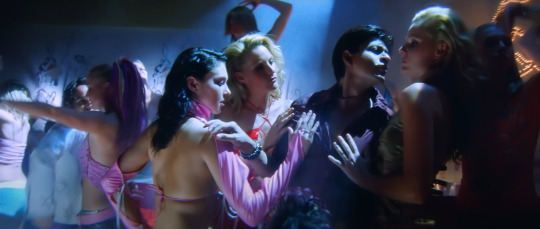
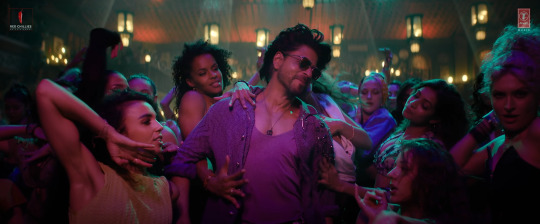
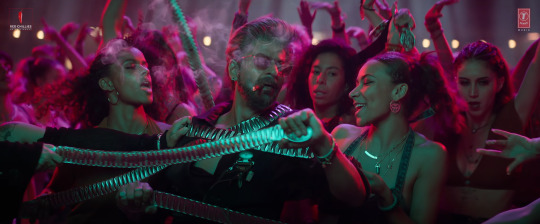
how the F*CK did i not realize this earlier
#film: kal ho naa ho#film: jawan#kal ho naa ho#khnh#jawan#shah rukh khan#srk#bollywood#local gay watches Bollywood.txt#opened up ITTTD for Reasons (*cough* fic *cough*) saw this frame and f*cking yelled. yelled i tell you what the f*ck#also looking back Aman should not have been doing all that at the disco. that man should not be at the club he needs to be getting#a heart transplant pls 😭😭😭😭#then again. then again. har pal yahaan ji bar jiyo fr fr let the man have experiences sksksksk
16 notes
·
View notes
Text
Sonic Character Cultural Coding
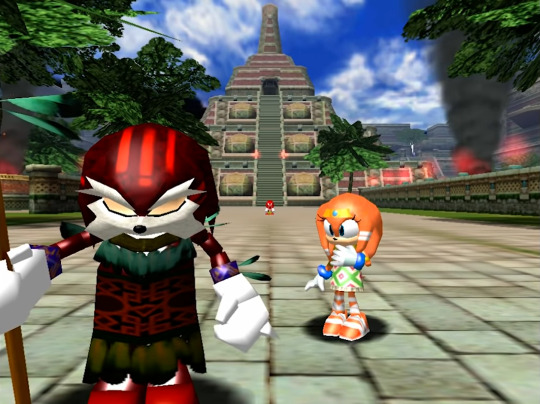
Despite the fact that a good chunk of Sonic characters are anthropomorphized animals, a large amount of them have been given explicit or implicit coding that aligns with cultures that we see on Earth! I’ve found it hard to find a detailed list of it all online, so... I made one!
Disclaimers:
I am going to say: some of these may seem pretty obvious, but at the same time I’ve seen people miss them, so I’ll be including both the “obvious” and “obscure” coding.
If I accidentally said anything offensive, please let me know so I can correct it!
We are going to start with Sonic himself, and then do the rest in alphabetical order! Let’s go!
Sonic the Hedgehog (+bio fam) – Egyptian
We’re gonna start with Sonic the Hedgehog himself– who is very much coded as Black, specifically of Egyptian descent.
In Adventures of Sonic the Hedgehog 1x50, “Robotnik’s Pyramid Scheme,” Robotnik goes back in time to try and prevent Sonic from ever existing by keeping his ancestors from meeting. Sonic goes back in time to stop him and we meet Masonic and Penelope who are Sonic’s great-great+ grandparents and live in ancient Egypt. Masonic is specifically designed to look almost exactly like Sonic.

Later in the episode they end up inside a pyramid and meet yet another ancestor of theirs, who is an enchanted mummy hedgehog. He gives Sonic a chaos emerald to kick Robotnik’s ass. He also looks exactly like Sonic.
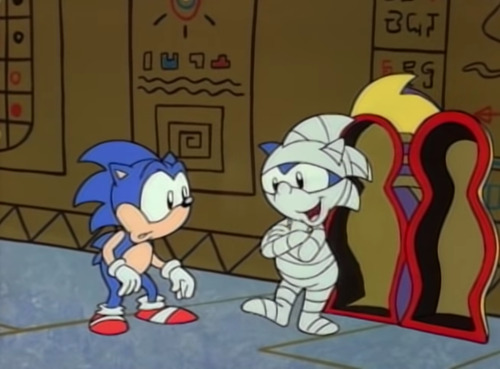
And SPEAKING OF enchanted mummy hedgehogs! In the Sonic Underground episode 1x22, “Mummy Dearest,” Sonic is AGAIN explicitly given ancient egyptian ancestry, when he and his siblings find a book talking about their family history. They use the book to find directions to a magic scroll which is protected by one of their ancestors, Aman-Rapi, who is again very clearly from Ancient Egypt and looks like Sonic.

In this pic, they can be seen posing in front of a wall containing heiroglyphs, with a mummy behind them, Amon-Rapi is literally dressed as a pharaoh wearing a variation on a Khepresh, his name is obviously a play on Amun-Ra… yeah, they’re Egyptian. So, in two different adaptations Sonic has been given explicit African ancestry.
@ifirestone also pointed out to me that Sonic Adventure 2 has a lot of hedgehogs all over the pyramid locations, and @nonbinarycharmybee pointed out that his shoes are based off of Michael Jackson’s shoes in the music video for “Bad;” Jackson is a very celebrated African-American musician. And @killer-squirtle pointed out that his design is most likely based on an African Pygmy Hedgehog, which live in “west, central and east Africa.”
Then in Sonic the Hedgehog 2 (2022), there’s a scene where Sonic messes with his quillstyle and is seen experimenting with different styles. Before he settles on the mohawk (very much resembling his AoSTH-SatAM style), he tries out what looks like a Flat Top haircut and Natural Afro; in the latter, he specifically strikes a pose very reminiscent of the 60s Disco Era, which was suuuper associated with African-Americans.
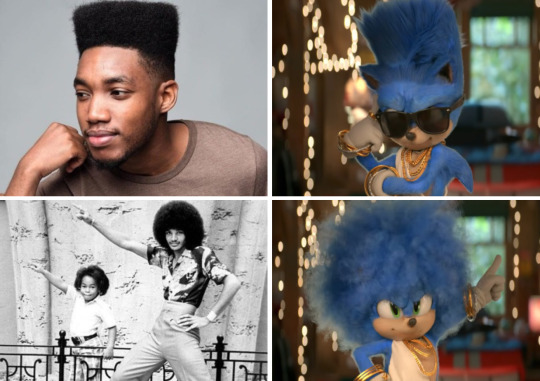
Finally (so far), Sonic’s first english voice actor was Jaleel White for the first three television shows, who is Black; he set the standard for english!Sonic’s voice and what he should sound like. Sonic’s newest VA for Sonic Prime, Devon Mack, is also Black!
Edit 07/15/2022: @birdsareblooming noticed that in Sonic and the Secret Rings, Sonic is reading the Arabian Nights in Arabic, which is the official language of Egypt as well as several other African and Southwest Asian countries!

As we’ve established Sonic is Egyptian, I think we can also safely assume that his bio fam is as well– Sonia and Manic were in that Underground episode after all, and as Underground doesn’t seem to give them a father I think we can safely assume that the royal lineage is through Aleena. Metal Sonic is a robot but as he’s supposed to be near identical to Sonic, I think we can put Metal under the same coding (no pun intended).
Antoine Depardieu/D’Coolette the Coyote – French

Antoine is very very obviously coded as French, first in the SatAM television show he debuted in and then in the Archie comics. His original surname, Depardieu, is a French surname– I don’t believe D’Coolette is a real surname but it is supposed to sound French with the “d’[x]” structure.
Antoine speaks in an exaggerated French accent, which is spelled phonetically in the comics so that it can still come across. He often (at least in SatAM– I’m not as knowledgeable on Archie canon) needs help understanding English words and asks for translations or butchers pronunciation. He also uses the French phrases “qui” and “sacre bleu.” Unfortunately, in SatAM he also falls into the French Coward Stereotype, which seems to have begun in the 40s and shot into prominence in the United States in the early 2000s.
Babylon Rogues (Jet/Wave/Storm) – Iraqi
The Babylon Rogues are ABSOLUTELY Iraqi. How do we know this? They are literally called the Babylon Rogues.
In case u didn't know, Babylon was an ancient empire that was p powerful in the BC years. Its capitol town– named, you know, Babylon– was an independent city-state and for a while the largest city in the world. They also had one of the seven wonders of the world, the Hanging Gardens of Babylon The city of Babylon, whose remains are now a world heritage site, is now what is currently Hillah, Babil Governorate, Iraq.

The Babylon Rogues are clearly named after the Babylonian empire. Their home base is also literally named the Babylon Garden, a reference to the Hanging Gardens. I’m not super knowledgeable on architecture, but the design of the Garden seems to be similar to the Umayyad or Abbasid architectural movements of Iraq.

This all very much codes the Rogues as being descendants of the Babylonian empire, ie: Iraqi.
Bark the Polar Bear – Russian

This is gonna be one of the shorter ones, but a 1996 interview with Hiroshi Kataoka, head of SEGA AM2, says that Bark is “a Polar Bear who lives in Russia.”
I don’t believe Bark is given any specific Russian coding following that, but it should be noted that that was the original intention.
Blaze the Cat – Southern Asian
Blaze’s concept designs can be pretty South Asian-coded first off; in the middle bottom row in the pic above, you can see her wearing Shalwar, (maybe shalwar kameez? it's hard to tell what kinda top she has) which is a popular Southern and Central Asian fashion.

Her final design includes a straight-up bindi– listed as such on the Sonic wiki. Bindi are a mark on the forehead worn by women in Hinduism, Buddhism and Jainism, and occasionally Islam (notably in Pakistan during Eid). While obviously anyone of any race can be of any religion, as the bindi originated in Southern Asia, it’s highly associated with that area and is worn by, well, a crapton of people in South and Southeast Asia, for both cultural and religious reasons.
Also, her kingdom: we don’t see it much in the games (in Rush Adventure, they’re mostly traveling through outlying islands and ruins), but we do see it in the IDW comics.

It seems very inspired by Mughal architecture, an Indo-Islamic style developed from Indian, Islamic, Iranian and Central Asian traditions.
In the mobile game Sonic Forces: Speed Battle, Blaze is given a costume for Lunar New Year, as is Silver (see Elise’s section for more Silver info). Lunar New Year is associated mainly with China, but is celebrated in several other Asian countries, including Indonesia, Japan, Malaysia, the Philippines, Singapore, South Korea, Thailand, and Vietnam.

We also got THIS tweet from the official Sonic account in November 2020, showing her having tea in her palace. @penosh-wom pointed out to me that the patterns in the room are “VERY reminiscent of India,” and that the scenery outside looks very much like the Asian coast.

The caption is in Japanese, but translating it to English shows that the descriptive is literally “Indian summer with calm waves.” An Indian summer is a term for unusually long hot weather in autumn, but like. Come on.
With that, I would say Blaze is most likely Indian, though the coding is a little vague. She is at the very least Asian, likely South or Southeast.
Bunnie Rabbot – Southern American

Bunnie seems to be coded as coming from the Southern United States (or at least the Mobius equivalent); she has a Southern US accent, for instance, and similar to Antoine in written media it is spelled phonetically so that it continues to come across; using “ah” instead of “I,” often cutting off the “g” in words ending in “-ing,” etc. Many of her sayings– such as “oh my stars”– are distinctly Southern US as well. This was all established in her SatAM appearances and continued into the Archie comics.
Should be noted that also, very unfortunately, one early Archie comic had her say several things to reference support for the Confederacy as a way of tying into her Southern heritage. Thankfully, as far as I’m aware this has only appeared in this issue and has never occurred again.
Princess Elise (+Soleanna, possibly Silver) – Italian

Soleanna as a country is incredibly inspired by the city of Venice, Italy, to the point where Silver’s original name was Venice. The city is known for being built on 118 small islands connected by canals and bridges, with it often being called the “floating city.”
The amount of canals and bridges in Soleanna is definitely an intentional reference, as well as the very Venetian Architecture of the buildings.
Now, Silver– While it’s unclear if Silver is from his timeline’s Soleanna, he does have a bit of Italian coding as well!

Firstly, his original design was literally named Venice. (design in the pic, bottom left.) And there’s one other little detail– in Sonic and the Black Knight, when you play as Silver (Sir Galahad), his sword looks a LOT like a Cinquedea– an Italian dagger.
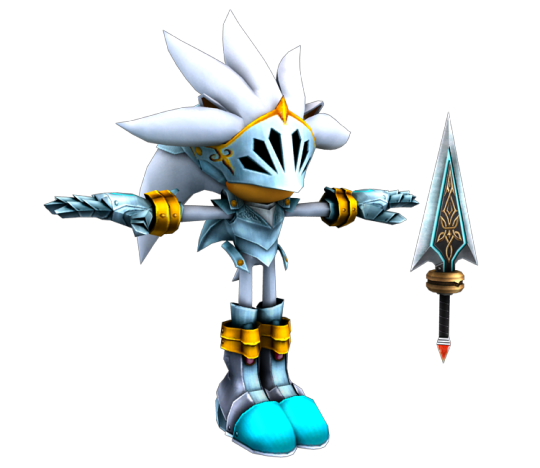
Silver being Italian is a bit less certain than the rest of Soleanna, though– the original name and dagger are the only implications and he hasn’t had much since. In Sonic Forces: Speed Battle he is given a Lunar New Year outfit, which could imply he is of Asian descent (see: Blaze); of course he could be mixed, or simply celebrating with Blaze (who also had a Lunar New Year outfit release at the same time). So while Silver isn’t certain, I will say the inclusion of the Cinquedea interested me enough to note him here.
Espio the Chameleon – Japanese
Espio is definitely coded as Japanese throughout his appearances. Firstly, and most obviously, his special interest in being a Ninja; ninjas were mercenaries or covert agents in feudal Japan, incredibly skilled in martial arts and ninjutsu, and they were often used as spies or bodyguards. Japanese legend would also often associate the ninja with invisibility, a major part of Espio’s powerset. Espio’s favor for the shuriken stars as a weapon also tie into this, as well as the fact that in the Japanese script he uses the old-fashioned formal pronouns “ware” and “onushi.”
That’s not all, though, of course: Espio has been stated in the Sonic City character profiles to be “a lover of traditional ways,” specifically referencing his ability to play the shamisen, a traditional Japanese instrument. He is seen playing this instrument in the Chaotix’s Sonic Heroes Team Blast.

@nonbinarycharmybee also pointed out that in THIS official artwork from Sonic Channel in 2021, Espio is seen writing with an ink brush used in Japanese calligraphy.
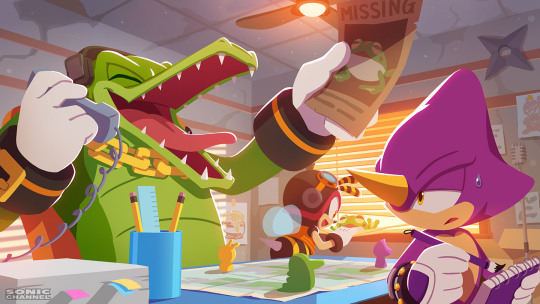
Gold the Tenrec – Indian
Gold is specifically stated by creator Evan Stanley to be from “whatever the Sonic World equivalent” of India is. This is shown in her design as well: her outfit consists of a brown sari, which is a very popular and traditional style in India, as well as nearby Southern Asian countries.
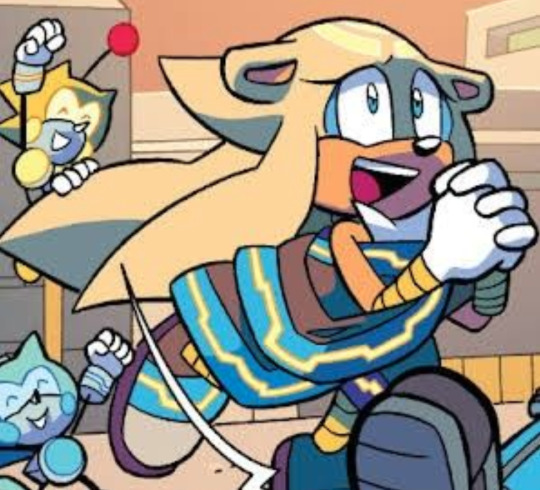
Knuckles the Echidna (+Clan) – Jamaican + Mesoamerican
Oooh Knuckles is interesting, strap in everyone!

According to Sonic Advance 2: Prima's Official Strategy Guide, Knuckles was originally intended to speak with a Jamaican accent. As well as this, the green/yellow/red color scheme of his shoes was intended to reference the Rastafari flag, Rastafarianism being a religion developed in Jamaica. This heritage can also be seen reflected in his dreadlocks– his quill-style is referred to as such in many canon places. In real life, dreadlocks are a Black hairstyle; the 2011 official census of Jamaica listed 92.1% of the population as Black, and dreadlocks are often associated with the Rastafari movement, as Rastas regard them as a symbol of strength and it emerged as a traditional religious style in the 1940s.
This isn’t the only coding Knuckles gets, though; he is known to be descended from the Knuckles Clan, which are heavily inspired by Mesoamerican cultures.

The Sonic Adventure team traveled through Central and South America to get inspiration for Knuckles’s clan’s culture, which can be seen in basically every aspect of the Clan lore. For instance, clothing worn by the echidnas is very similar to the traditional styles of the Aztecs and Mayas. This includes the decorative feathers seen on Pachacamac and the filmverse!Clan, as feathers were popular and prized materials in pre-colonial Mesoamerca.
Their architecture is almost identical to the step-pyramid temples of the Aztecs, Mayas and Toltecs. The same architecture and clothing style can also be seen in Sonic the Hedgehog 2 (2022), with most of the echidna warriors seen with spears, including baby Knuckles. Throwing spears were used extensively in pre-colonial Mesoamerican battles.
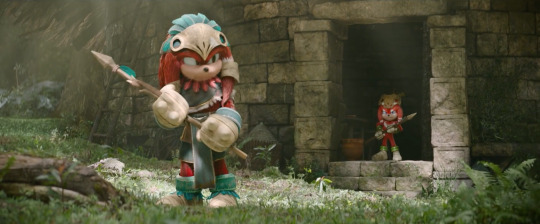
There is also a large serpent that lives near the Mystic Ruins of the Clan, likely a reference to the Aztecs’ Quetzalcoatl and the Mayas’ Kukulkan.
Also, most obviously, the names: Pachacamac is named after a Peruvian archeological site, which itself was named after the Ichma creator god Pacha Kamaq. Tikal, meanwhile, was named after the archeological ruins of a Maya city, consisting of multiple pyramids.
As a sidenote, it should be noted that Ken Penders’ echidnas in the Archie Comics were definitely supposed to be English: @thankskenpenders laid it out very well in this post, but they were written to come from “Mobius’s equivalent of England,” named after the earliest name for Great Britain, and he wrote the species to be “seafaring colonizers.” Penders did write this before the release of Sonic Adventure, but obviously after Knuckles’s initial release with Jamaican-coding, so can we call this whitewashing? I don’t know enough to speak on the subject, but with the reset of Archie comics and its later cancellation, and the games’ Knuckles Clan being represented in several other mediums (such as Sonic X, Sonic the Comic, etc.) I think we can safely say that the Mesoamerican coding is a bit more canon.
Lupe the Wolf (+pack) – Indigenous American

Lupe the Wolf first appeared in the second season of Sonic SatAM, and from her first appearance was incredibly indigenous-coded, as was her wolf pack. This coding continued through the Archie comics. This will mostly focus on the SatAM coding, as Archie pulled from that and, once again, I don’t know a ton about Archie!Canon, but SatAM is pretty damn obvious with its coding.
Lupe’s pack is described as being a native tribe to the Great Unknown region, who live in “harmony with nature.” Their land was captured and culture destroyed by the invading Robotnik, with the survivors retreating into their civilization’s ruins. In order to keep themselves safe, they set up inscriptions near their cave threatening to curse anyone who wanted to come in; Lupe later readily admits this to Sonic, Sally and Antoine, the latter of whom was scared shitless by the idea of getting cursed.
So, for starters, Indigenous American culture is, in general, built a lot upon a reverence for nature, believing that humans are not masters of nature but merely a part of it and acting accordingly. The capture of their land is obviously intended to be reminiscent of American colonization by the Europeans, which was devastating to the Native tribes, with entire cultures and languages being wiped out and Indigenous people still facing serious oppression in modern times.
Much like the Knuckles Clan, the Wolf Pack’s ruins are reminiscent of many indigenous archeological sites, such as Mesa Verde, which is also built into a cliffside. The brief glimpse we have of the Wolf Pack’s pre-colonized land also shows them living in huts reminiscent of many indigenous tribes.

The room Lupe gives exposition in also has them all sitting around a smoking fire pit; many indigenous cultures will gather around fires for meetings and discussions.
Lastly, many people (mainly white people) hold the superstition that Indigenous people have the ability to curse them; just think about how much the “this place is haunted because it was built on a Native burial ground” trope is used. The “Magical Native American” trope tends to say that Natives are magical because of their closeness with nature and “lack of civilization.” This very much falls into the Noble Savage trope, making them appear exotic or inhuman to outsiders and trivializes their connection to the natural world.
SatAM does a pretty decent job subverting this trope, with Lupe very clearly stating there is no curse and they use it to make small-minded intruders keep out; this shifts the ridiculousness of the situation onto the non-Native-coded characters.
Sonic: Ant! Forget the curse. There is no stupid curse!
Lupe: He's right, Antoine. We use the threat of a curse to keep out intruders.
Antoine: No curses? Oh. Phew and phew again. I am so happy to hear that.
- SatAM S2e10, “Cry of the Wolf”

There have been a few other instances of Indigenous-coding with Sonicverse characters, unfortunately not all of them represented as well. The inhabitants of Speedster Island in the Sonic Underground episode “Head Games” are just as indigenous-coded in their appearance, the episode very much falls into the “Native people need the outsiders to come save them” stereotype, as well as the “Native people mistake outsiders for gods” stereotype. The Gogobas in Sonic Boom are also given indigenous-coding with their chief’s headgear, village huts, and jokes made referencing the “cursed burial grounds” trope and them replacing the captured indigenous children in the parody of Indiana Jones and the Temple of Doom. The Gogobas are not exactly shown in a positive light, though to be fair, neither is anyone in the show; specifically, the Gogobas’ “tradition” is to guilt trip everyone into doing what they want.
For other indigenous coding in major characters, see Knuckles and Rotor sections.
Marine the Raccoon (+Coconut Crew) – Australian

Marine is very obviously coded as Australian; throughout all of her dialogue, she uses Australian slang, most obviously calling her friends “mate.” She also uses the exclamation “strewth,” which is used often in Australia and Aotearoa. Other slang includes “sheila” (woman), “no drama” (no worries) and “ya mug” (friendly insult, usually for a gullible person). The other koalas on her island, who raised her, also use the same language.
Marine is also given pigtails shaped like boomerangs, a tool heavily associated with Australia, specifically Aboriginal Australian hunting. Koalas are also a species that is native to Australia– I believe only Australia but I can’t be sure.
I don’t know enough about the coding of their architecture/etc to say if they’re coded as generally Australian or Aboriginal specifically, though I will say they definitely seem to be native to islands, which may imply they are of a Polynesian tribe near Australia or Aotearoa, such as Māori or Tahitian people.
Should be noted though that Marine appears to be adopted; she was raised by the Coconut Crew, who are all koalas. She does have some serious tanuki coding that may additionally code her as Japanese; for more, see Tails’s section.
Mina Mongoose – Chinese
As far as I’m aware, Mina’s Chinese-coding isn’t super explicit. However, she is seen wearing a red qipao for formal occasions, designed by Jeff Axer.
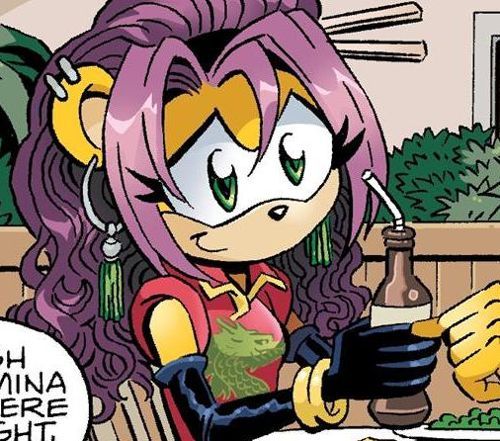
The qipao, also known as a cheongsam, is a traditional Chinese dress inspired by the Manchu people (founders of the Qing Dynasty). In modern times, the cheongsam is very popular for festivities such as weddings and holidays (especially Lunar New Year), as well as school and work uniforms.
Mina’s qipao is also specifically given a green dragon design very reminiscent of the Chinese dragon as well as many other Asian dragon species. She also is given ornamental earrings and hair pieces that are very clearly inspired by Chinese fashion.
Nocturnus Clan + Voxai Aliens – Roman/Greek
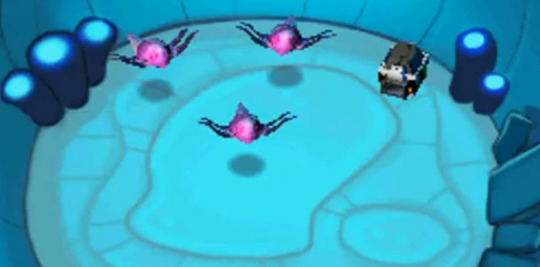
Honestly, these clans seem to have coding in name only– they both have specific cultures of their own, with the Voxai architecture specifically being based mainly on the rock and plants of their home planet, and the Nocturnus clan being very futuristic. But it is interesting to note!
The Nocturnus clan army ranks are very similar to Imperial Roman ones, with titles such as hastatus and praetorian. Ix being called the “Imperator” is also a Latin word from which the word “Emperor” is derived, and referred to an army commander. Ix’s Gizoid prefects are also named Scylla and Charyb, a reference to Scylla and Charybdis, two sea monsters in Greek mythology which appeared in the Odyssey. The historian character Nestor the Wise is named after King Nestor of Gerenia, also from the Odyssey as well as the Iliad.
The Voxai names are also derived from Greek and Roman mythology: their name likely comes from the Latin noun “vox,” which refers to a voice and would reference the aliens’ telepathic powers. Most of the named Voxai are given Greek names as well: Thebes is an important city in Greek mythology, Croesus was the last king of Lydia, and Riadne, Leucosia and Ligaia are names of mythological Sirens.
Rotor the Walrus – Inuk
Rotor is not given any specific cultural coding in SatAM or Pre-Super Genesis Wave Archie; however, in Post-SGW Archie, he and his family are given Inuit coding.

In the post-SGW comics, Rotor is from Artika, a region covered in snow and ice, and we see that the residents live in igluit, traditional homes for inuit in the Central Arctic Canadian area, and the Qaanaaq in Greenland.
Rotor’s community also has an enemy named Akhlut the Orca– in Inuit mythology, the akh’lut is a wolf-orca creature that is known to be aggressive towards humans.
Surge the Tenrec – Japanese

Surge is a relatively new character to the IDW Comics, so we still have more time to learn about her past/potential culture; for the most part, at this point, her coding comes mainly in her appearance. Surge was designed by Mauro Fonseca and Evan Stanley, with Fonseca listing Japanese delinquents, specifically sukeban, as one of the inspirations for her design.
Sukeban are Japanese delinquent girls, the word usually referring to either an entire gang or the leader herself; they were gangs in the 60s-70s, and now the term tends to refer mainly to fashion inspired by them. Many “common signifiers” of this trend are bright hair and modified school uniforms (cut, decorated, etc).
Many fictional Japanese delinquents share design similarities with Surge, such as “excessive piercings and jewellery” and spiked hair.
Tails the Fox – Japanese(?) / Kitsune

I put a question mark here because Tails’s coding isn’t specifically on Japanese culture, but on a very specific aspect of its mythology. Tails is very clearly based upon a Kitsune.
Kitsune are mythological foxes with the ability to shapeshift; they have been portrayed in different myths as tricksters and/or guardians. The kitsune are noted for having multiple tails; they are said grow a tail every hundred years, growing up to nine tails. When they reach a thousand years of age, instead of growing a new tail, they ascend to the heavens. The kitsune are notable for their shapeshifting and ability to create illusions.
Tails’s second tail is clearly a reference to the kitsune legend, but while he relies more on technology than magic, there are some suspicious magical incidents around Tails; in Sonic Battle, his attack consists of summoning a giant hand to hit you with. @birdsareblooming pointed out to me that in Sonic: Lost World, when Tails stops pretending to be roboticized, his eye color literally shifts from gray to blue, possibly as a reference to the shapeshifting.

In Sonic the Hedgehog 2 (2022), the illusion power is referenced with Tails’s “Miles Multiplier,” which he uses to summon holographic copies of himself and others.
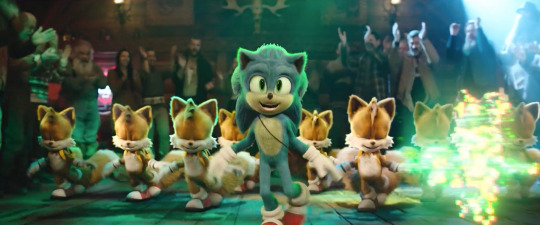
If you look on Tails’s desktop, you can also see something entitled “Kitsune” is running– @khamomile-kitty has informed me that it says Arms.Kitsune as a reference to Tyson Hesse’s early parody comic, Hedgehog the Sonic. You can see the file on the bottom left of his screen, though this isn’t a great pic lol.

There’s also the fact he shares many parallels with Infinite, who has the regular kitsune powers of illusion. Jackals are also very close on the family tree to foxes.
Another interesting thing is Marine– her being Blaze’s dimension’s Tails is interesting, as she is likely not a raccoon but a tanuki. She looks much more similar to a real tanuki, and in mythology tanuki and kitsune tend to be enemies with similar powersets. Speaking of Tanuki– Tails is also the first to be suspicious of Dodon Pa, a canon tanuki. He says specifically, “There’s something about this Tanuki I just don’t trust.”
Is he a kitsune in canon or is this just a reference to Japanese mythology? Pre-SGW Archie Comics gives Tails regular fox parents, so his tail seems to be a canon mutation there. However, every other canon has Tails completely oblivious to his past, seeming to not know his parents and likely having been abandoned. In Adventures of Sonic the Hedgehog, for example, he has no memory of his parents and just says he’s “been alone for a long time” and is confused at the fact not everyone has two tails. So honestly, it’s completely unknown whether he’s a canon kitsune or simply coded.
Whisper the Wolf – Japanese
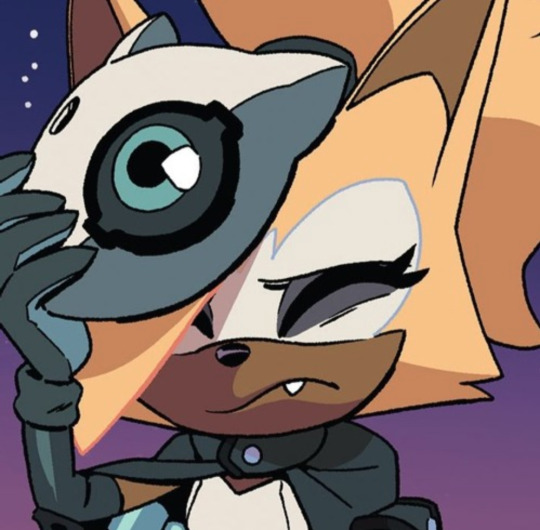
Whisper’s coding is very specific: her mask and her eyes. Whisper’s mask was chosen from a character customization option in Sonic Forces, and was specifically inspired by Japanese Kabuki masks. (Kabuki is a traditional Japanese dance-drama form known for its elaborate costuming, makeup, and masks.)
Whisper’s eyes being almost always closed is partially inspired by traditional depictions of kitsunes with “those iconic squinty-closed eyes.” (See Tails’s section for more kitsune information.) Sega of Japan approved her design as wolves serve the same roles as kitsune in older Japanese folklore.
Vector the Crocodile – Black American
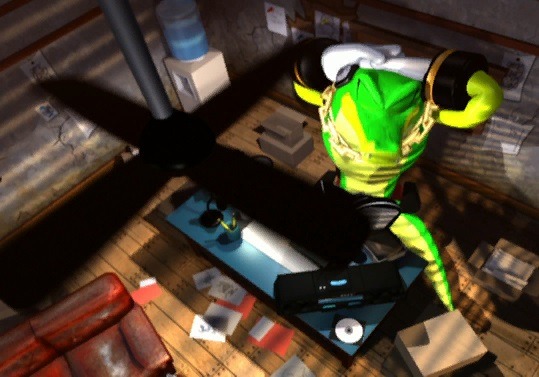
Vector has had quite a bit of black coding over the years, in both positive and negative ways.
Vector is given an appearance shared with/stereotypical of a lot of Black American musicians, particularly in the rapper and hip-hop categories– specifically, his gold chain jewelry, leather clothing, and wireless headphones, esp their positioning in his models. As Vector is a musician, they definitely chose this specific musican-attire for him for a reason. Also, right now, his current English voice actor is Keith Silverstein, a black man.
A lot of Vector’s personality could be read as stereotypical, and at the same time those personality traits could be seen as inverted depending on the source material: he could fall into the “bossy overconfident” stereotype, or that could be seen as subverted due to the fact he is actually competent at his job. He could fall into the “money-hungry” and/or “always poor” trope, or this trait could be seen as relatable due to all of us hating landlords and rent with a passion. He could be “will do anything for money” or he could be presented as someone with strong morals who will always do what is right.
In some media he is seen as hotheaded and aggressive (”Angry Black Man”), while in others he keeps a cool head in times of danger and takes care of his team. You could see him as a “massive flirt” or as just someone who happens to be head-over-heels in love with Vanilla. Hell, his loud music interest could be seen as joking about Black music being “too loud,” or it could be seen as him, you know, just enjoying music!
All this depends on the medium. I don’t feel educated enough on the subject to make a call as to whether he’s a positive or negative stereotype overall, though I think I can say with certainty that Penders’ writing of him in the Archie comics was racist as hell. As @thankskenpenders explained in her article, “Vector was the jive-talking comic relief character. He was obnoxious, he was dim-witted, he was crude, he’d randomly bring up rap music. One time he started singing ‘Dem Bones’ to himself while held captive by the Dark Legion. He was also extremely misogynistic.” Thank God Penders is out...
Master Zik the Zeti – Chinese

Zik’s appearance and characterization are based upon early Chinese poets, who are given a lot of respect in their society, as Zik is given respect among the Zeti.
Zik can definitely fall into the Inscrutable Oriental trope, with his “reserved and stoic” personality. He is also part of the Old Master trope (though he is a villainous rather than heroic character, as is traditional), which tends to intersect with the Magical Asian trope in martial arts stories, most famously in America in The Karate Kid; this inspiration can be seen in most of Zik’s calm dialogue and past as Zavok’s mentor, and the emphasis on his position as a powerful master. His hair is likely a reference to the stereotypical Fu Manchu moustache, and his entrance music is stylized after traditional Chinese music.
Zik also spends his semi-retirement in the garden he tends; this could potentially be a reference to Chinese gardens, which are very important in Chinese literature and philosophy. His game profile also mentions he likes to water his Bonsai tree; while the Bonsai is Japanese, it is derived from traditional Chinese penjing art.
3K notes
·
View notes
Photo


全部わかってしまったら...
Once I know everything, what should I do? — Misa no Uta
I had a few brainwaves about songs that totally work as Misa FST again, so I made another mix about her. This time I tried to stick to her anime canon characterisation as much as possible. There are also a few tracks about Light, Rem, and Takada in relation to her POV.
01. Savages - Marina and the Diamonds // 02. Holding Out for a Hero - Nothing But Thieves // 03. Emperor’s New Clothes - Panic! at the Disco // 04. Honeymoon - Lana Del Rey // 05. Immortal - Marina and the Diamonds // 06. Psycho - Muse // 07. Explosion - Zolita // 08. INTERLUDE: Devil Inside - London Grammar // 09. Twin Skeleton’s (Hotel in NYC) - Fall Out Boy // 10. 我們他們 - Ivana Wong // 11. Coming Down - The Weeknd // 12. Savage - LIGHTS
► LISTEN ON: 8TRACKS | SPOTIFY | TUMBLR (defunct)
(Other Misa Amane fanmixes can be found HERE and HERE.)
May 2020 update: due to various licensing issues, not all tracks in the 8tracks version may be playable. I have therefore also added a Spotify link, but please be aware that that version is missing the London Grammar track. the Tumblr version is no longer live.
Notes, translation, and commentary under the cut. Content warnings for song lyrics: drug use, ableist and abusive language, infidelity.
Haha, it’s not a Misa Amane fanmix from yours truly without an Ivana Wong song. Well, below is a translation of it. (Original lyrics can be found here.)
“我們他們” (Us; Them)
The gull sees the upper half of the sky’s colour1
The bat remembers the lower half of the hill’s shadow
The figure2 expresses dissatisfaction in the body also
Light and shadow3, how do we differentiate from the other half?
What are “we”? What makes “them”?
Even if I opened my eyes,
Gazed at that moon that is only half of itself,
Differences4, let us not mind them first,
Let us enjoy the full moon together
Could we exchange our feelings with each other?
Assuming that our positions are swapped with one another?
The morning flower is grateful for the first half of spring’s sights5
The red maple regrets the second half of autumn’s eyes6
Looking back at “us”; understanding “them”
What are “we”? Who is knocking on the door?
Even if I opened my eyes,
Gazed at that moon that is only half of itself,
Differences, let us not mind them first,
Let us enjoy the full moon together
Could we exchange our feelings with each other?
Assuming that our positions are swapped with one another?
The paper crane moves to reside7 in the upper half of the sky
The bullet buries itself in the lower half of the sea of flames
Understanding “us”; looking back at “them”
Grey hues, how do we judge shades of black and white?
In the centre, how do we criticise the left and the right?
Who are “we”? What makes “them”?
Who is knocking on the door? Who is willing to answer the door?
Notes:
“天色”: I’ve transliterated this into “sky’s colour”, but the phrase is usually taken to mean the time of the day (as evidenced by the colour of the sky), or the weather (again, as evidenced by the sky)
“身影”: I translated this into “figure”, as in a person’s figure. “Form” is a good alternative translation. Yes, it may seem to redundant as the line then goes on to refer to the person’s “body”, but that’s the point of the polyptoton I suppose.
“光影”: I transliterated this into “light and shadow”, but in most instances the phrase is colloquially taken to simply mean “shadow”.
“偏差”: I translated this into “differences” as it flows better, but that actually generalizes the original denotation a bit. A more precise translation would yield words like “deviation”, “divergence”, etc.
“春光”: A literal translation would be “spring’s light”, but “光” (light) can sometimes taken to mean sights or scenery, as in “風光”.
“秋水”: This one takes a bit more contextualizing. Literally, it translates into “autumn’s waters”, but at times it’s been used idiomatically as a metaphor for clear, limpid, feminine eyes. I mashed the two denotations together to produce the current translation, “autumn’s eyes”. I am unsure which denotation the songwriter intended, probably both? (Well, that’s the norm in Chinese poetry and lyrics, metaphors and double entendres tend to be inherent in most visual imagery.) In any case, I made sure to include a nod at the idea of watery, feminine eyes because it’s Misa we’re talking about here, in this mix.
“寄居”: A more unequivocal translation would be “moving away from one’s home to live someplace else temporarily”.
(This translation + notes have been adapted from the version at @pocketsizedthoughts.)
More about this song later. I’ll go through the tracks one by one.
To be honest, knowing this was going to be my 3rd Misa mix gave me expectations for myself. I tried to affect the kind of intertextuality I achieved in my second Misa mix, where I sustained lyrical references between its tracks and the stuff in my first Misa mix. Hence, the inclusion of Lana’s Honeymoon on this mix again, to hark back to the aesthetics on my second Misa mix. I also included The Weeknd’s Coming Down as a cheeky nod to Halsey’s song of the same name (which is included in my second Misa mix). Halsey and The Weeknd’s songs are very different animals though – here’s some graphics I edited to compare the two songs in the context of Light, Misa, and Takada’s triangle. (More on this comparison later.)
The idea for this mix came about when I first listened to LIGHTS’s Savage. I thought it would make a fun bookend to Marina’s Savages (which asks the existential questions of human nature reminiscent of Light’s Kira), sort of like an antanaclasis of the word. But more importantly, LIGHTS’s Savage (“What do you do when a man don’t love you?”) reminded me of the realisation Misa achieved in Misa no Uta (“zenbu wakatte shimattara dousureba iino?” / “once I know everything, what should I do?”). (Again, please read Kim @casuistor’s brilliant dissection of Misa no Uta for a better understanding of how the scene shapes Misa’s anime characterisation in comparison to manga!Misa’s characterization.)
So, there was the starting point for this mix. You can see that I’ve uncreatively used the quoted lyric from Misa no Uta as the title for this mix. The cover artwork is my attempt at mimicking the anime’s shot of Misa staring out towards the sunset as she contemplates her usefulness to Light in Misa no Uta (a scene that, as Kim pointed out, is then paralleled in her suicidal contemplation at the end of the anime).
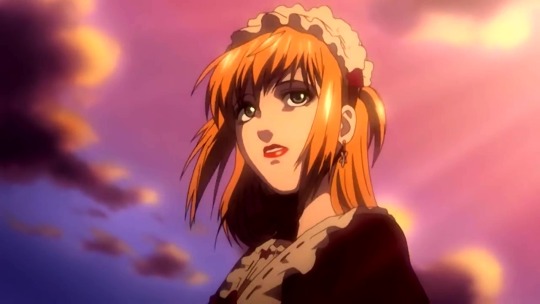

Unlike my first two Misa mixes, which are decidedly canon-divergent in the way it characterizes Misa (i.e. much brasher, and more autonomous than even Misa no Uta suggests), I tried to stay closer to the anime characterisation whilst branching out a bit to include the POVs of her surrounding characters as well. Sure, Marina’s Savages sounds like it could potentially be a monologue for Light and Misa both, but Emperor’s New Clothes, Psycho, and Twin Skeleton’s (Hotel in NYC) unmistakably represents Light’s voice in this story. In other words, the tracks with masculine vocalists are all Light’s theme tracks. You can also tell by the bombastic sounds and boastful and grandiose tone of the lyrics – they suit Light’s character as he is in canon.
I also gave Rem a voice; I figured she deserves to finally be included in a mix about Misa’s story. I only recently discovered Zolita and her song, Explosion, which works so much better than any previous candidates I had in mind as a theme for Rem. (The narrator in the song is speaking from a sapphic POV, for one.)
And though Takada wasn’t exactly given a track that narrates from her POV, she is also referenced in her relation to Light in the tracks Devil Inside and Twin Skeleton’s. The latter from Light’s POV of course (“I need a new partner in crime”); the former from an objective POV. You’ll also notice that Devil Inside is designated the “Interlude” of the playlist. It may not have neatly divided the mix into two equal halves, but it does mark the point at which Takada enters the narrative again as part of the Kira squad. “Here comes a woman, with a look in her eye,” indeed.
Anyway, enough of me waffling about the general course of the mix’s narrative direction. I promised a track-by-track breakdown. Here it is.
Savages
As stated, this works as an opener for the Kiras in general, questioning human nature and its capacity for violence and destruction. The song does retain a certain tone of self-deprecation and self-awareness that I think places it a bit further away from Light’s egomania though, hence I thought it more fitting for Misa’s perspective. The line, “I’m not afraid of God, I am afraid of man,” cements this, anyway.
(There’s a chance Marina intended for “man” to be an encompassing term for human beings regardless of gender, but I think it fits Misa if we interpret it as a gendered term; she is a victim of two crimes committed against her and her family both by male criminals, after all.)
“Are you killing for yourself or killing for your savior?” Here’s another line I’ve twisted slightly to suit the meaning of my mix. I’m sure Marina was referencing suicide bombers and other sort of religious terrorists out there, but if we turn this around, Misa is also literally killing for First Kira, who she sees as her “savior”.
You can hear it on the news
You can watch it on TV
You can read it on your phone
You can say it’s troubling
These lines also fit well with Light’s rhetoric of seeing crimes on the news day-in day-out, and just the general relationship the Kiras have with the media towards the last arc of the story.
Holding Out for a Hero
Don’t laugh, I know you’re probably thinking of the Shrek OST. No, hear me out. I specifically chose this cover of the song because it has this darker edge that is absent in most covers of the song, which obviously suits the tone of Death Note as a series. But also, Conor Mason’s wailing vocals simply make for a good expression of Misa’s desperation before she was “saved” by Kira.
Where have all the good men gone
And where are all the gods?
Where's the streetwise Hercules to fight the rising odds?
Isn't there a white knight upon a fiery steed?
Well, the idea of “the gods” is just too cheeky a reference to Kira’s self-proclaimed godhood for me to not include this track. The idea of this hero being “larger than life” is also very fitting for Light’s kind of Kira, who wishes to reform the entire world on an abstract level.
The line, “streetwise Hercules to fight the rising odds”, perfectly encapsulates the idea of the “rising odds” of crime on the street. Plus, it corresponds to the lyric from Misa no Uta, “Hold my hand in the dark street”. Sort of. The fairytale image suggested in the next line is also something Misa herself has voiced in canon, calling Light her “knight” in shining armour.
And of course, I also chose this song for its latent intertextuality… “It's gonna take a superman to sweep me off my feet” – a nice little nod to Taylor Swift’s track, Superman, as is included in my second Misa mix.
Emperor’s New Clothes
(Finders keepers, losers weepers)
Welcome to the end of eras
Ice has melted back to life
Done my time and served my sentence
Dress me up and watch me die
If it feels good, tastes good
It must be mine
Dynasty decapitated
You just might see a ghost tonight
Oh, yes, there’s no doubt by the sound of the bombastic trumpets and the self-indulgent lyrics that this is a song fit for Light’s entrance. “Finders keepers, losers weepers” – that’s just him talking about the Death Note. Whoever finds it, keeps it, and he will rise above while L and other adversaries lose to him.
Now, I’ll admit that this song is better placed as a “comeback” song for when Light regains his memory (“I’m taking back the crown”). It’s even suggested in the very first verse, the one I quoted (“Done my time and served my sentence”). And I’ve always been aware of this – long before I made this mix, I made an edit for this idea of the song being an FST to EP25. But I needed a definitive song for Light’s introduction into this mix, and this song is most characteristic of him. So just… turn a blind eye ear, and focus on the opening line, “Welcome to the end of eras”. It’s Light’s way of saying it’s Kira’s era now (the era of the New World).
Honeymoon
This is just such a perfect song for Misa’s character, I couldn’t resist including it again on this mix. The combination of its lush, orchestral sound and Lana’s croons really channel Misa’s romanticism and penchance for fashion and style. And of course, the imagery of the singer’s lover being a criminal pursued by his enemies is just a perfect fit for Misa’s relationship with Light. (I mean, look at this gifset. It’s a perfect match for the lyrics, jesus.)
As mentioned in my notes for the second Misa mix, the lines, “There’s nothing to lose now that I’ve found you,” and, “There’s no wonder every man in town / had neither fought nor found you,” really punctuate Misa’s entrance into the story – at this point in the narrative, she is the only one to have found First Kira, and it gives her peace of mind now that she has found her “savior”.
So, this track offers a twofold reference. There is the obvious reference to my second Misa mix, in which this song basically opened up the rest of the mix and set the stage for the narrative there. And then the very idea of “finding” someone or something also functions as an echo of the little notion of “finders keepers” in Emperor’s New Clothes. It’s a cheeky little parallel I’m going for here: while Light finds a purpose in a tool with which to create his New World, Misa finds a different purpose in an object worthy of her affections. Hence, why I inserted this song right after the other one.
Immortal
This track is included as a spotlight on Misa’s character. Although I’ll admit, the desire to achieve godhood in the opening line is less characteristic of Misa than it is of Light, the logic that Marina works through in the lyrics to arrive at the conclusion that “Love” is the only thing that can achieve immortality is quite like Misa’s worldview. She is a strong believer in the power of love, and all that stuff.
By the bridge, this song is in full-swing Misa mode:
No, I don't wanna be afraid,
Afraid to die, die, die
I just wanna be able to say
That I have lived my life, life
Oh, all the things that humans do
To leave behind a little proof
But the only thing that doesn't die is love, love, love
“Oh, all the things that humans do / to leave behind a little proof,” – this line gives this song just a touch of self-awareness and deprecation that, again, distinguishes it from Light’s character. But it is just like Misa to face death with courage or bravado, as she did during confinement and would rather beg for death than reveal First Kira’s identity. It is also like her to say that having loved and be loved would give her existence a bigger meaning.
Psycho
Love, it will get you nowhere
You're on your own
Lost in the wild
So come to me now
I could use someone like you
Someone who'll kill on my command
And asks no questions
This is the opening verse of the song. Yes, ironic, isn’t it, in the way it counters the beliefs espoused in the previous track? That is exactly what I intended. Of course, in canon, Light would never voice these thoughts to Misa’s face. But it does create a good contrast to Misa’s character, and reveals the core nature of their relationship – built around lies and promises of false love.
The rest of the song sounds even less like something Light would say to any of his supporters. I’ll admit, when I first found this song, I just thought it would work as an expression of Light’s inward attitudes towards the other Kiras. Mikami, in particular – he is indeed just a foot soldier to Light’s sergeant (which is the story acted out by the two monologuing voices in the background of the track). But for the sake of this mix, let’s just ignore this separate thread… Anyway, Misa is also a pawn for Light to use, she even says so when she first throws her affections at Light. Yeah, you get the idea that I’m not a proponent of their relationship by now.
Explosion
It's a mindless love affair
One hot mess of bleach blonde hair
As stated before, this track is intended to be an interjection from Rem about her feelings towards Misa. I particularly chose to place it at this point in the mix because in canon, Rem does issue a threat and a warning to Light the night Misa offers to be used by him: after he callously states that he could just kill off Misa if she is going to be difficult about his fake-dating covers with the other girls, Rem tells Light that she would kill him if he causes harm to Misa in any way, shape or form.
That is the gist of the line, “Don't call me about him I don't wanna hear / Put him out of your mind just make him disappear.” In my mind, there is no doubt that Misa must have at some point felt put off by the callous attitude Light displays towards her. At least, with the way she expresses her disagreement with his decision to date several girls at once upon their first meeting, it’s safe to say she does feel frustration in her relationship with Light. And as we can see from the conversations between Rem and Misa, the two obviously trust each other; there is a roommates vibe going on between them (in anime!canon, at least). It’s not such a stretch to imagine Misa spilling her guts, including her relationship troubles, to Rem at some point.
But lesbian!Rem takes a bit more headcanoning. I know that this isn’t confirmed canon by the anime, but hey, gay!Rem is a real thing in the musical, and I’m always going to stan the idea of Rem being a lovesick fool for Misa. She has “feelings” for her, after all. Hence, “Are we sisters or are we lovers?”
So then, the last line of the song, “you’re mine, you’re mine, you’re mine…” isn’t really a confirmation of the two being romantically involved together. It’s more an exclamation on Rem’s end, an expression of her possessiveness and overall concern for Misa’s safety and happiness (especially knowing Light’s god-awful treatment of her).
Devil Inside
I designated this track as the interlude because the slow start of the song provides a bit of a lull in the mix, which is perfect for preluding the switch in narrative direction to introduce Takada’s character.
The other reason it’s only an “interlude” and not a standalone track is that it is a relatively short song; this cover stops just short of the bridge of the original. As such, I don’t have much to add in commentary either. I’ve pretty much already said all that I have when I pointed out earlier that this song introduces Takada – the point in canon when she is enlisted by Light as a potential Kira-proxy:
Here comes the woman
With the look in her eye
Raised on leather
With flesh on her mind
Words as weapons sharper than knives
Makes you wonder
How the other half died
Again, this is a bit of a pick-and-choose-your-context kind of song. Takada is certainly not “raised on leather”. Actually, when I first heard this song 2 years ago, I had conceived of it as more of a study of Light and Misa as a couple. Misa has “the look in her eye”, because she has the Shinigami Eyes.
However, that would also be unfaithful to the canon characterisations of them and their relationship. (Misa may wear leather on occasion, but she is not a wielder of words as weapons…) And anyway, Takada also gets the Shinigami Eyes later on in the series. And she certainly has more of an eye for ambition and sociopolitical fame than Misa does. So she has a “look in her eye” in both senses of the word. And since she is a news anchor, with the kind of intelligence a To-Oh graduate has, she certainly has the ability make her words hurt if she wants them to. (Case in point: her pissing contest with Misa at their dinner “date” right before the pop music festival. She is the one to go on offense first.)
But what I like about this song is still how it pairs the woman and the man in the lyrics by their crooked, murderous nature. Check out the parallelisms between the 2 verses:
Here come the man
With the look in his eyes
Fed on nothing
But full of pride
Look at them go
Look at them kick
Makes you wonder
How the other half live
By this part of the song, it’s fair to say this can refer to both Light’s relationship with Misa and with Takada at once. “Look at them go / look at them kick”: Misa’s relationship with Light is falling apart, but Takada’s relationship with Light doesn’t exactly end in rainbow and unicorns either. “Makes you wonder / how the other half live”: easy, the women don’t. (Takada is killed by Light, and Misa dies indirectly because of him when she commits suicide.)
Twin Skeleton’s (Hotel in NYC)
Another song with masculine vocals, this one for Light’s POV on his and Takada’s relationship. Bar the bit about how this hotel is located in NYC, most of the lyrics fit the scene in Ep.32, where Light has a ~secret rendezvous with Takada at the hotel.
I will concede, the line, “I don’t want to remember it all,” is also out of character for Light considering that he would probably saw off his left toe before he’d be willing to give up his memories again, but yeah… just ignore it :/
I just need enough of you to dull the pain
Just to get me through the night till we're twins again
Ahh, this one is a bit obscure in meaning, but someone pointed out that the twin imagery is more alluding to people who think alike, and Takada certainly started becoming Kira’s unofficial spokesperson before Light even enlisted her to be one, because they share the same ideals about justice. (But also, I’ve always thought that there are similarities between Takada and Light’s looks. The hairstyle, the kind of clothes they wear, etc. Takada’s the closest option to a genderbent version of Light in canon.)
'Til we're stripped down to our skeletons again
Following the same logic in the line, “I just need enough of you to dull the pain”, the idea of being “stripped down to skeletons” is another display of brutal honesty and genuine emotions from the narrator of the track. Except, I do believe that in the context of Light being the speaker, this should be taken with a grain of salt. He is an adept liar, after all, and in canon he does lie convincingly to Takada about his affections (or lack thereof).
'Til we're saints just swimming in our sins again
This line takes the POV out from the immersion however, since Light and Takada most certainly will no acknowledge their actions as being “wrong” or “sinful”. They do see themselves as saints, but only saints, in their actions as Kira / Kira-proxy.
And there's a jet black crow droning on and on and on
Up above our heads droning on and on and on
Keep making trouble 'til you find what you love
I need a new partner in crime and you shrug
The last line in the verse here is the one quoted in my mix annotations, and it’s pretty obviously a variation of what Light says when he appeals to Takada. What I want to talk about, actually, is the imagery of the crow. The crow is often used as a symbol of Death or as an omen for some other trouble. Here though, the former connotation works, as Ryuk is literally poised above the Kiras in all instances as he watches in entertainment. But the risk of being caught by the task force or the SPK is also a constant danger that hangs above their heads.
我們他們
The original meaning of this song is far from apolitical.
Grey hues, how do we judge shades of black and white?
In the centre, how do we criticise the left and the right?
These lines condense the imagery of borders and binary opposites throughout the song into a very clear message of how what’s right and what’s wrong are often not clear-cut ideas that one can just pick apart and confine to two separate groups. There are shades of grey in every discourse.
(And while the phrase, “the left and the right,” is referring to the two opposing political ideologies, it also makes for a good wordplay for rightness and those that are righteous. Light and the Kiras are self-righteous. (But to be honest, they are also quite right-wing conservative in their beliefs about the death penalty…))
Again, in the same vein as Immortal and Savages, this awareness of the arbitrariness of moral judgment without excluding the speaker’s own flaws from the same observations suits Misa’s character more than it does Light. She understands very well the grey morality of her actions (sacrificing the few that get in their way) whereas Light is more inclined to wave away those murders of the innocent with the justification that it’s not the same when he does it because he’s “God”.
But I also chose to include this song in the track-list because the divide between “us” and “them” can simultaneously reference the differences between Misa/Light’s faltering relationship and Light/Takada’s increasing closeness. (“Us” = Misa/Light, “Them” = Light/Takada.) So then, the idea of someone “knocking on the door” to Misa/Light’s relationship, and Misa questioning which one of them is willing to open the door to external enquirers, is a nod to the track, Dollhouse (as featured on my second Misa mix), which presents the idea of a dysfunctional marriage and its imperfections being hushed up from the outside world.
And at the chorus, we have the navel-gazing that really characterizes this song as a Misa theme track:
Even if I opened my eyes,
Gazed at that moon that is only half of itself,
Differences, let us not mind them first,
Let us enjoy the full moon together
Ironically, although Misa has the Shinigami Eyes, the ability to see through lies of fake names and such, she is willfully blind to Light’s emotional manipulation for most of the anime. Even after her realization in Misa no Uta that she should not longer be needed once she “knows everything”, she chooses to stay with Light. And that is exactly what is represented here, in this chorus. Even if she “opened her eyes” to the lies between herself and Light, gazed at a Raito (月; “moon”) that only shows half of his whole self, and realise the distance between them, she will not mind it and continue to stay with their shoddy excuse of a holy union. (Oh, yeah, in Chinese culture, full moons have the connotations of family reunions. So the imagery of a “full moon” here can mean two things: (1) the illusion of Light being his whole self in front of Misa, or (2) their marriage itself.)
P.S. I’d like to think the line, “The bullet buries itself in the lower half of the sea of flames,” is a neat little echo of the lines, “There are guns that blaze around you / … / And a fire that surrounds you,” from Honeymoon.
Coming Down
Again, masculine vocals = Light’s POV. This song may be the least in-character for him, however, since The Weeknd’s lyrics always retain a little bit of self-deprecation, and this song’s no different. We could read these lyrics from a different angle though, and imagine Light apologizing / acting the victim as another tactic to manipulate Misa’s sympathies. That’s what a lot of manipulative partners do, anyway. And those with battered woman syndrome do tend to believe the abuser’s excuses, believing that the abuser will be better “next time”.
But, as pointed out by the juxtaposed graphics in my edit, he is clearly two-timing Misa and Takada.
Pick up your phone
The party's finished and I want you to know
I'm all alone
He is not really “all alone”, because he had Takada on the side. And he only asks for Misa as a second-choice, he only returns to her when the “party” (rendezvous with Takada) is over.
The refrain, “I always want you when I'm coming down,” is just like Light when he tries to sweet-talk with Misa, making Misa feel wanted and loved by the man she is forever infatuated with. But like the edit, it’s also a direct reference to the Halsey track of the same name, Coming Down, on my second mix. Both songs are of course talking about the experience of coming down from a drug-induced high, but as discussed in the other mix’s notes, I am taking this as a metaphor for coming down from some sort of delusion. While for the Halsey track, I am talking about a canon-divergent Misa letting go of the delusion that Light would ever reciprocate her feelings in a way she wants him to, for this track, I am talking about Light taking a few steps back from delusions of grandeur and full-blown prideful dismissal of the rest of the world. Specifically, I am thinking of the scene in Yellowbox Warehouse, where towards the end when he is begging for his life, he asks for Takada, then Misa. He needs Misa at his most vulnerable, when he can’t accept his defeat.
Savage
But then, fate denies Light from reuniting with Misa, even if just to use her. While Light begs for his life, Misa sits in the Teito Hotel, memories erased, and none the wiser. Ironically, Misa’s involuntary inaction parallels her doubts about her own feelings since, as mentioned in @casuistor’s meta, Misa is aware of the fissures in her relationship with Light. Even before she learns of Light’s death, she is starting to lose faith in her marriage, as she knows that Light no longer “loves” her the way he did in the first part of the series. And that moment in Misa’s life is, in essence, what this track captures.
But I didn’t choose this track simply for its resemblance (“What do you do when a man don’t love you”) to the mix’s titular lyric of Misa no Uta, or the nice little bookend it makes relative to the opening track, Marina’s Savages. There are other nuances to this track that makes it a perfect closer. For one, it recounts the start of the relationship, right before the decay began.
I was hangin' next to you
By a thread from so high
We were heaven and the moon
In the center of my eye
And now it shines on you
And I would kiss your crown
These lyrics at once recall (1) the moon symbolism in Light’s character (thus corresponding to 我們他們); (2) how he entered Misa’s life when she spotted him through Shinigami Eyes vision, subsequently becoming the “centre” of her universe; (3) how the two once reigned as God and Goddesses of the New World, from a “heaven” of their own (which, by the way, is intended as a reference to Halsey’s Young Gods from the second Misa mix), yet (4) even in their high places, Misa was always living hanging on by a thread, emotionally-speaking, because she was always dependent on him; and (5) how Misa viewed him as her king, whose “crown” she would worship with her love (and this, in turn, corresponds well with the decadent imagery in Emperor’s New Clothes).
The religious imagery continues in the second verse of the song, as well:
So just say it like you mean it
Won't you scream it out like it's religion
You were the priest and the prophet
You were my scripture and my conviction
Again, this sums up how Misa viewed Light as her savior at the start of the series, and how he was a symbol of her convictions and beliefs about the karmic occurrences in her life (i.e. the criminal that killed her parents getting killed in turn).
But if Light is a god, he is not a forgiving one, as he is capable of unleashing a “flash flood of cruelty” (like God did in the Old Testament to wipe out His flawed creations). I think by the end of anime!canon, when Misa is clearly struggling with alcoholism even in EP.33 (during her dinner with Takada), she is most definitely aware of the cruel side of Light.
The cruel actions of the singer’s lover is elaborated in the hook of the song:
But when you hung up the phone and you blocked my number
I was alone in the rain and thunder
This feels a bit like a direct answer to The Weeknd’s Coming Down. It really shows that even though Light can call Misa on a whim, basically ensuring the Misa is at his beck and call, this is not reciprocated, because he is not easily accessible from Misa’s end.
And finally, in the chorus:
What do you do when a man don't love you?
He takes the sun from the sky above you
How do you fix the damage? How do you break the habit?
I never knew you could be so savage
As discussed before, when the singer makes the final accusation, within the context of this mix, it really turns the question around to accuse Light that is no better than the mere mortals that is deemed “savages” by Kira’s judgements (in Marina’s Savages). But the line, “How do you fix the damage / How do you break the habit,” is also very telling of Misa’s psychological state. She knows of the faults in her relationship with Light, but she cannot find it in herself to quit it.
#death note#misa amane#deathnote#deathnotefanmix#death note fanmix#stvlti's mixes#stvlti makes stuff#stvlti edits#dn fanmix#// the commentary is 6k words long... yeah... 6k... i definitely went overboard this time
62 notes
·
View notes